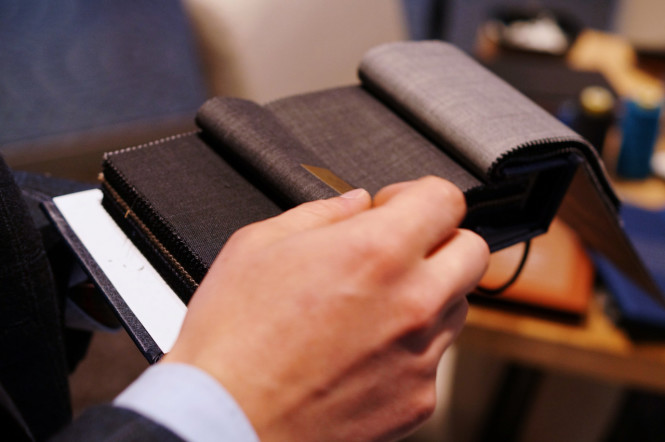Part 1: Cloth and Customization
There’s been a decent amount of chatter about Beckett & Robb, a made-to-measure clothing outfit from Salt Lake City that recently came to San Francisco (admittedly, a good deal of that chatter has come from my blog). I have seen their products in person a few times and have spoken about how their company works but since I have never owned one of their products the information I’ve given has been limited. Fortunately, that is about to change – I decided to approach Beckett & Robb recently and asked that they make a suit for me.
Although a large portion of the project financed by myself, in the interest of full disclosure I should make it clear that I am receiving a discount for sharing my experience. Nonetheless, I am putting my money where my mouth is and I will be honest about the whole process. I have been curious to learn more because the company’s business model seems to offer a good product.
Nonetheless, it took a while before I decided to give Beckett & Robb a try. Although their company sounded promising on paper I was still skeptical after looking through their online product photos. The suits were often very “GQ” – cut agressively slim and short, with “flashy” fabrics and details. However, when I met Dustin (one of two people working in their SF store in Embarcadero Center) I immediately felt a sense of camaraderie in the way we dressed. His suits and sportcoats were made by Beckett & Robb, of course, but he dresses with a very classic sensibility and I was happy to see that his product was able to capture that. This was crucial for me; I wanted to make sure that I shared the idea of how a suit should look with the person helping me design it. Our conversations about favorite blogs and looks we love (and hate) have only reaffirmed that we have similar views of what the end product should look like.
Beckett & Robb carries wonderful fabrics from a wide variety of high-end mills. These include Loro Piana, Zenga, Reda, Vitale Barberis Canonico, Ariston, and more. They have dozens of fabric books that are truly delightful to flip through. It’s worth noting that although two-piece suits start at around $700, the fabric selection at this pricepoint is limited. Most of their selection is above the $1000 mark. In fairness, some standard fabrics were out of stock when I went in and I believe that they are looking to expand the selection below the $1k point. Nonetheless, I went in looking for a standard mid-grey worsted wool and found that it didn’t really exist in the standard fabrics – there were dark and light gray worsteds, mid-gray flannels,mid- gray worsteds with purple pinstripes, but some holes in basic categories like gray and navy (at the sub-1k pricepoint). I don’t think that this is a “bait and switch” tactic, just the reality of the stock they have combined with the fact that all the mills they use are well-known and expensive. Nonetheless, it’s worth pointing out.
I ended up picking out a lovely mid-gray 10.5 oz. fabric from VBC that I can’t accurately describe – it definitely isn’t a typical worsted wool; it carries some texture (but isn’t a flannel), and is very interesting for a solid fabric. It is pictured above. After the stress of agonizing over fabrics Dustin and I poured a drink and moved on to the details.

The choices for suiting details were plentiful. There were extensive options for liner fabric, pockets, lapel style and width, horn and corozo buttons, trouser style, and so forth. I went with very straightforward options – flap pockets, average notch lapels, waist side adjusters, and lightly structured shoulders. In my MTM experiences I find that starting simple is essential. You should look at the first made-to-measure (or bespoke, if you’re lucky) experience with a maker as the beginning of a potential relationship – start by dipping your toes in the water, for your sake and theirs. Your first order is a starting point. Refrain from succumbing to the siren call of “customization,” which can lead to a more expensive (and less wearable) garment, which is especially frustrating if it doesn’t turn out how you expect.
I also think that when beginning a MTM commission it’s important to go in knowing what you want (and making sure that it aligns with what that company produces). Dustin did a great job of providing good input when I needed it but had I gone in with no idea of what I wanted it would be easy to end up with an unfamiliar product. Go in with a strong sense of what you need and take advantage of their expertise where your own knowledge is limited.
Although the fitting and design generally take place in one meeting, I spent so long debating over fabrics that we had to call it a day and schedule the fitting for another time. My experience in that arena will be up soon.

